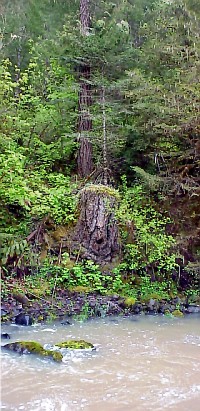~~* The Singing Falls Stream Restoration Project *~~
 ϕ
ϕ
~~* Temperature and its Role in the Watershed *~~
Not only are the returning salmon few in quantity. But once spawning has taken place the young anadromous fish must endure the gauntlet of hot summer temperatures which takes a very high toll of their number.
From ancient times the salmon runs were comfortably adapted to the stream temperatures. The native indigenous people logged very little of the riparian zones. To this day it is very evident that old growth trees grew untouched in the stream sides here at Singing Falls. The old growth stumps testify that the practice of logging the stream banks was brought to this region by Europeans.
The large trees were removed and there was very little in the way of brush to cover the stream pools where hatchling fish customarily spend their summers. That made the stream temperature rise.

Old growth riparian stump supporting new growth
All woody debris was removed from the stream by law in the mid 1960's. This caused massive amounts of gravel to be washed down stream. This made the stream temperature rise.
Gravel has important tasks to perform in the stream. Not only does it provide material to build nests for spawning fish but shelter for very young fish when they first hatch. One of the most important tasks for gravel is to keep stream temperatures down. When water flows through a gravel bed it cools down considerably. It is hidden from the sun. Water is also purified by passing through gravel. The clear water is less likely to absorb and retain heat from the sun. It tends to reflect it instead. Gravel also tends to limit the drastic swings between day time and night time temperatures. During the day it absorbs heat from the water. At night it releases heat into the water thus moderating temperature extremes that otherwise would be there. With the gravel now missing the stream temperature has risen.
With extensive clear cutting the springs and ponds that once fed the streams dry up due to exposure to direct sunlight.There is less water flowing now than in the old days. That makes the temperature rise.
And last but not least we should take note that literally millions of beavers have been trapped out of Oregon. The regions surrounding this part of the state, and in particular our watershed, have been stripped of its beaver populations. There are very few thriving beaver colonies in our area. This means that the millions of gallons of water that were once retained by the ingenious and industrious pond builders is gone. Less water flows in the streams. This makes the stream temperatures rise.
Yes the temperatures have risen and many thousands of young fish are stressed, fall prey to disease, become very vulnerable to predation, and die.
One of the primary indicators of a healthy watershed is cool clear water. For that reason we have been documenting the water temperatures in Joe Hall Creek since the salmon have reappeared. It is because this once year around flowing stream now heats up and dries up that we have been doing our fish rescue the last few years. It is also the reason we have set out to keep a record of stream temperatures prior to and subsequent to the aquatic habitat restoration work we have done. With blessings of good rains and the resultant readjustment of stream conditions the pools and gravel deposits will begin to function as they did through times long forgotten. Cool clear waters will once again be nurseries for the young salmon and sea going trout.
Now that we have established the “why and wherefore” of this section of our project have a look around.
If you have found valuable on line information with regard to the impact of temperature on fish populations please forward that information to us. We'll post it here.
| Images and Temp Charts | NOAA Umpqua Temperatures |
top






